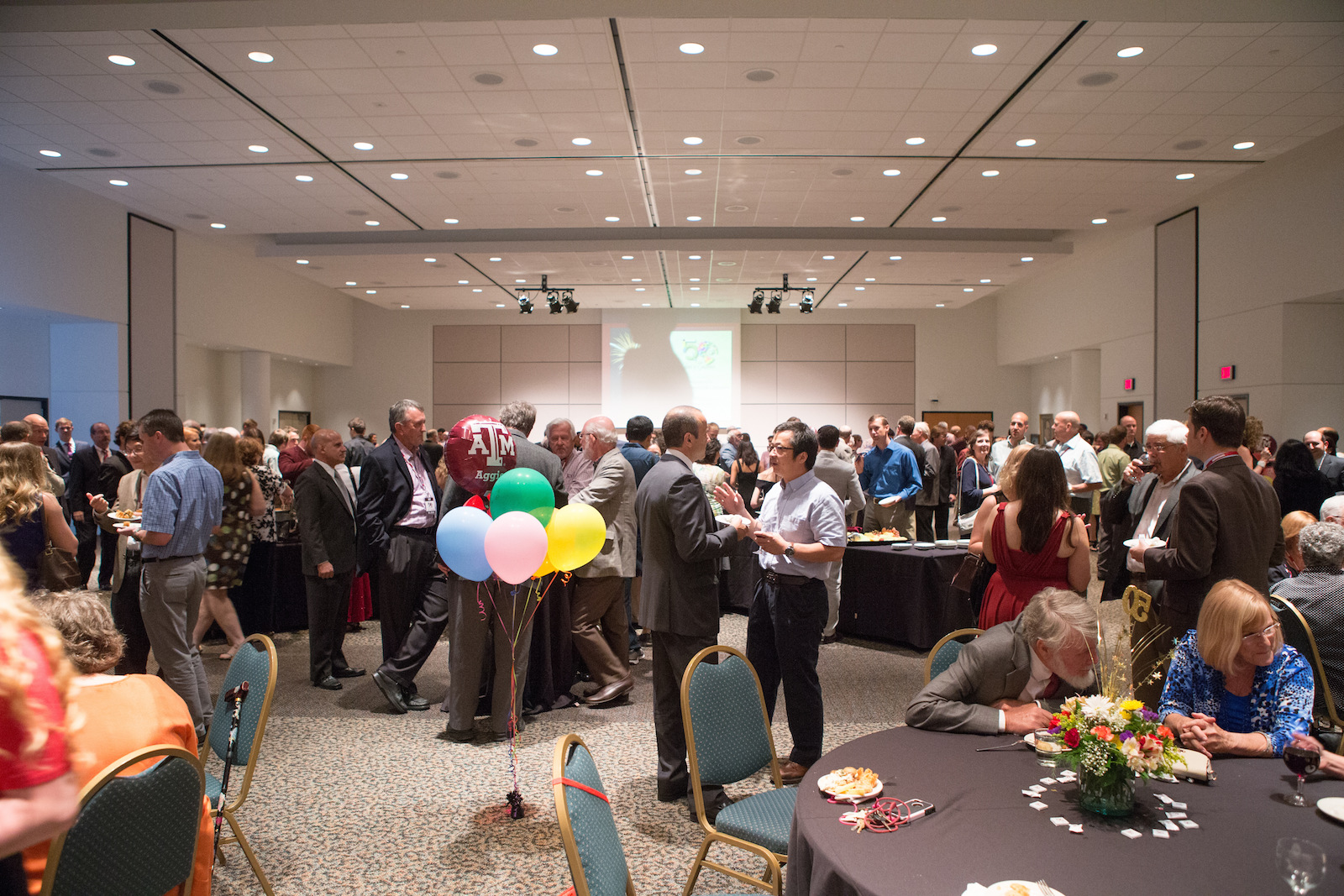Geosciences: 50 Years, More Than 10,000 Students, 1 College
Dec 15, 2015
The College of Geosciences celebrated its 50th anniversary on Oct. 1 during a gala reception and program featuring Texas A&M President Michael Young, former dean of geosciences, Robert Duce and geosciences former student, Stuart Burbach '77. More than 300 students, former students, friends, faculty and staff gathered together to celebrate a rich history and look towards a bright future.
 Geosciences 50th Anniversary Gala
Geosciences 50th Anniversary GalaOn Oct. 1, 1965, then-Texas A&M President Earl Rudder with great prescience, officially approved the formation of the College of Geosciences, and it was quickly on a path to remarkable work. The Texas Sea Grant Program was established soon after in 1968 to study Texas coastal and marine issues, and it boosted Texas A&M's status as a land-grant, sea-grant institution. Space grant was added to the mix in a few more years, making the school just one of a handful in the United States to have the rare triple designation.
From unique studies on weather and historic droughts, to air pollution and how it affects everyone on Earth, from exploration and development of oil and gas reserves to taking never-before-seen photos of the Martian terrain, the College of Geosciences faculty has produced some of the world's most critical and timely research and has taught new generations of geoscientists to follow in their footsteps ‹ more than justifying Rudder's signature in 1965.
"Our college's many contributions in the last 50 years have been life-changing," said Dean Kate Miller, "and just as important, our faculty has done an outstanding job of graduating students who continue the work around the world in the many occupations concerned with Earth's systems. Our future looks incredibly bright ‹ as notable as the last 50 years have been, the next half-century should be even more impressive."
Miller adds that the faculty, staff and students of the college adhere to its mission: that of advancing new understandings of the Earth system and applying them to the needs of society, and preparing the next generation of geoscientists to conduct research, to find and develop natural resources, and to measure and respond to environmental change.
With two percent of the university's total enrollment ‹ it is one of the smallest of Texas A&M's 12 academic units ‹ the College of Geosciences receives about 20 percent of the university's research dollars in federal funding.
The face of the student body has certainly changed, going from almost all male of a little more than 200 students in 1965 to today's enrollment of nearly 1,500. Some of the college's largest gains have been made in the last six years, with enrollment increasing 56 percent and more than one-third of the undergraduate classes coming from under-represented or first-generation families.
Today's students in geosciences are far more likely to have global experiences than those from the college's earlier days, whether through studying abroad, being part of research expeditions at sea, or participating in service projects in Costa Rica and Mexico. In fact, study abroad participation in the College of Geosciences increased 38 percent this past academic year, the largest percentage increase on campus.
Today's geosciences students are also more likely to participate in undergraduate research, including some departments where more than 50 percent of the students have one or more semesters working with professors on original research.
Threaded throughout the college's history is the importance of high performance computing in transforming the discipline. Reliance on data-intensive analyses is now more important than ever, says Miller.
"The World Economic Forum describes big data as the new economic asset," she said, "as important as gold or oil. And we see it in our field, whether it is the advent of the digital oil field, complex modeling of weather patterns and climate change over time or our new degree in Geographic Information Science and Technology."
One of the areas of research relying on integrated data analysis is scientific ocean drilling. The college manages the largest research grant in Texas A&M's history the International Ocean Discovery Program (IODP). It is the largest, sustained NSF-sponsored geosciences program in the world, contributing more than $2.5 billion to the local and state economy. For 30 years, it has enhanced the international reputation of the university. Its research has rewritten textbooks, and its scientific contributions to the history of global climate change, of tectonic processes and of the evolution of life beneath the seafloor is invaluable.
The Berg-Hughes Center for Petroleum and Sedimentary Systems is investing in the "data-driven" oil field to find more efficient ways to identify and recover oil and gas in unconventional formations. The Gulf Integrated Spill Consortium, a $14-million grant from the BP settlement, seeks to understand and predict the fundamental behavior of petroleum fluids in the ocean environment.
In addition, faculty, students and staff have achieved a number of "firsts:" the first to drill into the Japanese trench to better understand the processes underlying the 2011 earthquake; the first to develop and operate the camera system for Mars exploration, including the current Mars rover Curiosity; the first to measure and monitor the levels of oxygen deprived water ‹ called hypoxia ‹ in the western Gulf of Mexico; the first to launch successfully a system of ocean observing tools in the Gulf of Mexico, including underwater and surface drone-like devices; the first and only university to curate the cores from the San Andreas Fault; and the first and only scientific team to provide consistent monitoring and reporting of the human impact on the environment at McMurdo and Palmer stations in Antarctica.
Such key research has attracted considerable media attention in recent years, and the college's faculty routinely appears or is mentioned in such outlets as The Weather Channel, USA Today, FOX News, CBS, NBC, ABC, the BBC, the Wall Street Journal, the New York Times, and dozens of other media outlets around the world, from Austin to Auckland.

